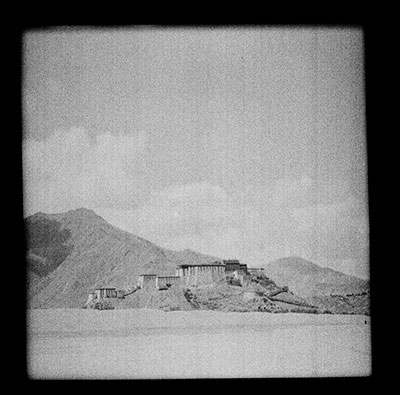
2001.59.8.2.1 (Film negative)


2001.59.8.2.1 (Film negative)

Hugh E. Richardson
Hugh Richardson
May-June 1939
Lhasa > Potala (from north)
2001.59.8.2.1
55 x 57 mm
Negative film nitrate
Donated August 2001
The executors of the estate of Hugh E. Richardson
Hugh E. Richardson
Manual Catalogues - Notes on negative album '8' - 'Potala. Colour misc.' [on front cover] [KC 9/9/2006]
Manual Catalogues - Notes on negative index '8' - Folio 2. 'do' [Potala from N.] [KC 9/9/2006]
Other Information - Dates: This image can be related to a group of 13 6x6 images which have contact prints with the batch development number '512' in red printed on them. These seem all to have been taken on, before or just after Richardson's tour to Talung in May 1939. Richardson visited Betsang on this trip, where he photographed nomads. The number relates also to the '512' batch development numbers printed in black on 21 6x9 images. The 6x6 and 6x9 images would have been produced using two different cameras demonstrating that by this time Richardson was using both a Reflex Korelle and a Zeiss Super Ikonta and that the batch numbers on contact prints may also correlate with each other across print sizes to assist in dating [MS 17/12/2005]
Other Information - Setting: The Potala Palace is the winter Palace of the Dalai Lamas and the seat of traditional Tibetan government. The palace is know as several names by the Tibetan, Tse Podrang, ( rtse pho brang ) or more formally, Potala Podrang ( pho brang po ta la ) The first structure was established by the legendary Tibetan Emperor Song Gampo on Mt Marpori in 637. The original structure is said to have been 11 stories high and was destroyed by lightening during the reign of Emperor Trisong Detsen. The present structure was built by the 5th Dalai Lama on the foundation of the earliest ruins. The Potala is divided into two parts, the central upper part is known as the Red Palace ( pho brang mar p o) and the surrounding structure is know as the White Palace ( pho brang dkar po ). The Red Palace contains the main temple inside the palace and housed the reliquaries of the successive Dalai Lamas. The Red Palace also represents the original structure build in the 7th Century. Between 1645-1653 the 5th Dalai Lama added the White Palace and made it the seat of his government. Since the 17th Century, the White Palace has formed the main administrative offices of the Tibetan government and it became the seat of Tibetan government only in the 18th Century when the 5th Dalai Lama shifted his base from Gaden Palace in Drepung monastery to the Potala. There are said to be over 1000 rooms and over 200,000 images inside. The grounds of the Potala also housed a school known as Tse Lobdra ( rtse slob grwa ) 'The Peak School'. The students were mostly boys from aristocratic families and trained to become government officials. The palace was also the site of two printing presses the older one known as Ganden Phuntsog Parkhang ( dpa’i ldan phun phyogs par khang ) founded in the 17th Century and in 1920s the 13th Dalai Lama established the Shol Printing House ( zhol par khang ). [TS 27/6/2005]
For Citation use:
The Tibet Album.
"Potala from the north"
05 Dec. 2006. The Pitt Rivers Museum.
<http://tibet.prm.ox.ac.uk/photo_2001.59.8.2.1.html>.
For more information about photographic usage or to order prints, please visit the The Pitt Rivers Museum.
© The Pitt Rivers Museum